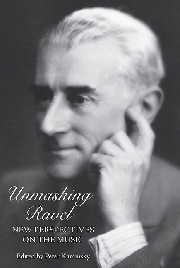Book contents
- Frontmatter
- Dedication
- Contents
- Acknowledgments
- Introduction
- Part One Orientations and Influences
- Part Two Analytical Case Studies
- 4 Ravel's Approach to Formal Process: Comparisons and Contexts
- 5 Repetition as Musical Motion in Ravel's Piano Writing
- 6 Playing with Models: Sonata Form in Ravel's String Quartet and Piano Trio
- 7 Spiral and Self-Destruction in Ravel's La valse
- 8 Diatonic Expansion and Chromatic Compression in Maurice Ravel's Sonate pour violon et violoncelle
- Part Three Interdisciplinary Perspectives
- List of Contributors
- Index
8 - Diatonic Expansion and Chromatic Compression in Maurice Ravel's Sonate pour violon et violoncelle
from Part Two - Analytical Case Studies
Published online by Cambridge University Press: 05 September 2013
- Frontmatter
- Dedication
- Contents
- Acknowledgments
- Introduction
- Part One Orientations and Influences
- Part Two Analytical Case Studies
- 4 Ravel's Approach to Formal Process: Comparisons and Contexts
- 5 Repetition as Musical Motion in Ravel's Piano Writing
- 6 Playing with Models: Sonata Form in Ravel's String Quartet and Piano Trio
- 7 Spiral and Self-Destruction in Ravel's La valse
- 8 Diatonic Expansion and Chromatic Compression in Maurice Ravel's Sonate pour violon et violoncelle
- Part Three Interdisciplinary Perspectives
- List of Contributors
- Index
Summary
At the first performance of Maurice Ravel's Sonate pour violon et violoncelle on April 6, 1922, some critics were shocked by what they referred to as a “massacre,” because of its supposed abundance of “wrong notes.” While this invective is incongruous with a work of such beauty and logic, the “wrong-note” conception nevertheless implies a certain “mischievous” quality that is manifested initially in the bimodal (minor/major) duality of the first movement. It is striking that the first movement of the Duo Sonata, published in La Revue Musicale on December 1, 1920, was followed by three more movements that were composed in the midst of Ravel's work in May of 1921 on his opera, L'enfant et les sortilèges, whose dramaturgy and music expressly invoke the mood of mischief.
The intention in this study is to show how Ravel's Duo Sonata exhibits what may be appropriately termed “mischievous” transformations between diatonic (i.e., symmetrical minor/major) constructions and a more abstract chromaticism.1 These two conflicting spheres—modal and chromatic—are linked by means of intermediary intervallic stages. These stages include the octatonic scale especially, a symmetrical construction that represents a partial chromatic compression of pentatonic and diatonic intervallic content. These stages include other symmetrical (cyclic-interval) pitch constructions, as well. Harmonic transformation in the Duo Sonata actually reflects some of the “sardonic” contrasts and interactions so important to the musico-dramatic character of L'enfant et les sortilèges. This seems to be more than mere coincidence, given the overlapping dates of composition.
- Type
- Chapter
- Information
- Unmasking RavelNew Perspectives on the Music, pp. 211 - 242Publisher: Boydell & BrewerPrint publication year: 2011



